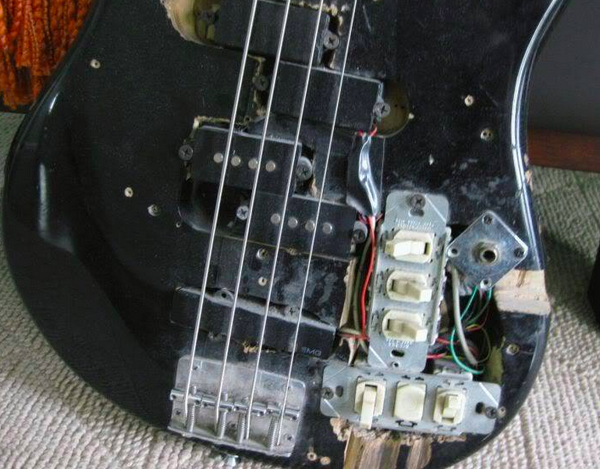(originally published in Bass Player Magazine)
But…I Repeat Myself by Ed Friedland
If you’re a bass player, you are already aware of the tremendous power we wield. We carry a lot of responsibility at work. Charged with keeping the groove, outlining the root motion of the chord progression, preserving the form of the tune, and supporting the music in the best possible way for that moment—it’s a big job with many facets, and the most successful players do it as naturally as breathing.
There is another aspect to bass playing that many players don’t consider—how the bass line can make a song a hit or a flop. The magic element here is repetition. In classical music, a repeating bass line is called an ostinato. We already understand that the bass is the rhythmic and harmonic foundation of the music, it’s what makes John and Jane Q. Public get up offa their thing. But in my experience, most people don’t really get the bass, at least not right away. The low frequency range of the instrument makes it harder for the untrained ear to discern the details that will draw them in. A listener will lock right in on a vocal line or a guitar riff, but it often takes many times listening to a tune before the bass line gets into their heads. But once the listener grasps the bass line, you own them. The question is, how can we make that happen? Repetition. Repetition in the bass line is perhaps one of the most important elements to make a tune popular. Consider Rick James “Superfreak”. The mere mention of that song starts the classic bass line playing in your head. The constant repetition of the phrase got through to every listener very quickly, making it a smash hit for James, and MC Hammer when he sampled it for “Can’t Touch This”. If you examine the bulk of recorded music, repetitive bass patterns whether rhythmic or melodic are at the heart of the most popular songs. People instinctively want to grasp what the bass does in a tune, it’s the key to feeling the music, and that’s what makes them dance, or simply nod their heads.
Let’s look at a few examples of this principle in action. James Brown’s music was certainly popular in his early years, tunes like “Please, Please, Please” (hmm.. repetitive isn’t it?), and “It’s a Man’s World” were big hits for him. But, when the Godfather changed over to simple ostinato bass lines like “Cold Sweat”, “I Got You” and “Papa’s Got A Brand New Bag”, his popularity went through the roof. The Red Hot Chili Peppers first few albums were terrific, and featured some of Flea’s more active, go-for-it bass playing. They achieved success, but not in comparison to their later work when his playing became more subdued and repetitive. The great Motown hits featured very active bass lines by the great James Jamerson, yet his ability to be creatively repetitive was a big part of what made those songs popular. If you look at how dance music tends to over emphasize the bass frequencies, you see right away what they are going for. In classical music, a piece like the Pachelbel “Canon in D Major” has a circulating bass pattern that has earned the piece the distinction of being “the most loved piece of music of all time” (at least that’s what the TV announcer said). On a jazz gigs, I’ve noticed the audience response is way stronger after playing a song that revolves around an ostinato bass line, like “Gray and Visceral”, a John Scofield tune that is based on a repetitive 6/4 bass lick
And, what about jazz? Although it is appreciated worldwide, it’s popularity can’t even touch that of rock, r&b, pop, etc. Why is this? I posit that in addition to the more advanced harmonic, rhythmic, and melodic aspects of the music, the bass line is too fluid for the average listener to grab ahold of. While a jazz walking bass line has the constant quarter-note feel (hence the ubiquitous comment “Bass? Oh yeah, Boom, boom, boom!” by people trying to signal they know what you do), the melodic content changes so often that there are no familiar hooks for the listener. Dave Brubeck’s “Take Five” is probably the most well known jazz tune of all time, it has a catchy melody, and the intellectual appeal of being in 5/4 time, but most importantly—it has an ostinato bass line that people can hear right away. Another memorable tune, “Killer Joe” features a repeating walking bass hook from C7 down to Bb7 and back up. Horace Silver’s “Song For My Father” is introduced and underpinned by a repetitive Latin bass figure that grabs the listener within seconds of hearing it. It is undoubtedly Silver’s most popular tune, and the bass intro was famously copied by Steely Dan for “Ricki Don’t Lose That Number.” Herbie Hancock has enjoyed a long, storied career as one of the highest regarded musicians in jazz. His most well-known compositions are undoubtedly “Chameleon”, whose simple funky bass line is instantly recognizable, “Watermelon Man”, and “Cantaloupe Island”, two “Bluenote Boogaloo” style songs that also have simple, repetitive bass lines. Even within the jazz world, the more avant garde styles where the bass doesn’t walk or play familiar patterns tend to have a smaller audience.
I’m not suggesting that free-form players should abandon their musical direction, or even that music should be written with audience acceptance in mind—the choice is your own. If an ever-changing, constantly evolving bass line is what you hear for your music, so be it. My point is simply this—artistic freedom in the bass line and large-scale popularity are rarely found together. Is it coincidence that having the bassist play the same thing over and over is a common factor in most popular music? I suggest if you want to take over the world, create a really strong, repetitive bass line that people can latch on to. Once the sub-harmonic mantra has invaded their consciousness, they will do your bidding—or at least listen to your music.
If you play free form music, play in a jam band, or just haven’t learned to lock in with a repetitive idea, try this experiment on your next gig or rehearsal. Come up with an idea, a lick, a riff or whatever you call it, and play it over and over. See what happens. The other players will start to create parts that fit with your line. The band will gel around the bass part and create a strong groove. It feels good doesn’t it?
I am not suggesting that being popular is the ultimate goal for a musician, or a band, or even for a style of music. However if we examine how repetition in the bass line effects the appeal of music, we become aware of yet another aspect of our power as bassists.
Awareness is power, use power consciously, repeat yourself and be popular! Awareness is power, use power consciously, repeat yourself and be popular! Awareness is power, use power consciously, repeat yourself and be popular!






This is so present in any genre, my brain immediately thought of ‘it’s your thing’, scofield example also reminds of ‘Camelus’.
I wonder why our brains latch to a repetitive bassline what does it say about what our brains like. why are we comfortable with long free forming melodies in the treble range and less so in the low end. Are we just culturally groomed in to this taste or has it always been so.
wonderful article